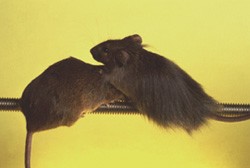
Touching base | Nature Genetics
- Select a language for the TTS:
- UK English Female
- UK English Male
- US English Female
- US English Male
- Australian Female
- Australian Male
- Language selected: (auto detect) - EN
Play all audios:

MUTANT OF THE MONTH Credit: Gail Martin For our readers who fancy long-haired breeds, we present the classical mouse mutant angora as our May MoM. The original angora mutation, described in
1963 by Margaret Dickie, arose spontaneously in a litter of BALB/cJ mice at The Jackson Laboratory. The molecular defect responsible for this long-haired phenotype remained a mystery until
the early 90's, when Gail Martin and colleagues used gene targeting to generate a null allele of _Fgf5_ and discovered that these mice presented an exact phenocopy of the original
angora mutation. They went on to show that the _Fgf5_ null allele failed to complement the angora mutation and that angora mice carry a deletion spanning the _Fgf5_ translational start site.
Fgf5, a member of the fibroblast growth factor family of secreted ligands, is expressed in the outer root sheath of the hair follicle and is required for timely progression from the anagen
(follicle generation and hair production) to catagen (follicle regression) stage of the hair cycle. In the absence of Fgf5, the transition to catagen is delayed, resulting in extended growth
of the hair shaft and abnormally long fibers. The JAX website describes the appearance of angora mice as shaggy. We prefer lush and flowing, and we suspect the mice would agree. _KV_
NECESSARY IMPROVEMENTS In the United States, most testing for mutations in _BRCA1_ and _BRCA2_ to identify genetic susceptibility to breast and ovarian cancer is performed by Myriad
Genetics, which holds patent rights on the tests. Mutation screening includes sequencing of exons and flanking regulatory regions in _BRCA1_ and _BRCA2_ and testing for specific recurrent
rearrangements in _BRCA1_. Since rare rearrangements or copy number changes are not detected with this approach, the interpretation of negative test results in high-risk women (those who
have severe family histories of breast or ovarian cancer) is problematic. Mary Claire King and colleagues have now published a study that determines whether high-risk women who have received
negative test results do in fact carry an undetected mutation (_JAMA_ 295; 1379–1388; 2006). The authors detected rearrangements in _BRCA1_ or _BRCA2_ in 35 of 300 (12%) high-risk women who
previously received negative results from commercial tests, supporting the case for global screening for rearrangements in families with negative test results. By quantifying how often
Myriad Genetics' tests yield false negative results, this study puts pressure on the company to improve the sensitivity of their tests and to provide more comprehensive testing to women
at high risk. _EN_ ELECTROPHEROGRAM AND LOATHING Life is too short to read bad sequence in good papers, so I propose a solution. It is rare for editors to endorse any product, but we are
prepared to make an exception for software that makes the lives of our authors and readers easier. Most sequence traces submitted to us as figures are inadequate for the purposes of
illustration. The electropherogram usually has insufficient pixels to meet the requirements of our Guide to Authors and often the baseline will be omitted. The relative size of the lettering
must be greater than 4-point type when reduced and placed in the context of the figure. We prefer nice bright colors too. We will publish, in Touching Base, the names and links to any
manufacturer whose software produces sequence traces that meet the exacting standards of our Production Editors. Freeware and available community software also qualify. Readers should also
feel free to condemn inadequate software in our blog, Free Association. The prize for us will be that we will never have to return a figure to an author or to hold up publication of a paper
because of its sequence data. _MA_ A JUMP-START FOR STEM CELL RESEARCH It was a big boost for stem cell researchers when the California Institute for Regerative Medicine recently announced
that the first grant funding will flow from the state's stem cell agency, to the tune of $12.1 million. Up until now the agency had not been able to deliver the $3 billion of
voter-approved funding because it has been mired in lawsuits brought by opponents of the research. But the agency, thought to be the largest funder of stem cell research in the world, has
outmaneuvered its detractors by selling bond anticipation notes to private investors. Bypassing the ongoing litigation, the Institute used the money raised from these notes to immediately
fund stem cell grants. The funds are being used to support training grants for predoctoral, postdoctoral and clinical researchers at 16 California research institutions. _EN_ _Touching Base
written by Myles Axton, Emily Niemitz and Kyle Vogan_. RIGHTS AND PERMISSIONS Reprints and permissions ABOUT THIS ARTICLE CITE THIS ARTICLE Touching base. _Nat Genet_ 38, 509 (2006).
https://doi.org/10.1038/ng0506-509 Download citation * Issue Date: May 2006 * DOI: https://doi.org/10.1038/ng0506-509 SHARE THIS ARTICLE Anyone you share the following link with will be able
to read this content: Get shareable link Sorry, a shareable link is not currently available for this article. Copy to clipboard Provided by the Springer Nature SharedIt content-sharing
initiative
